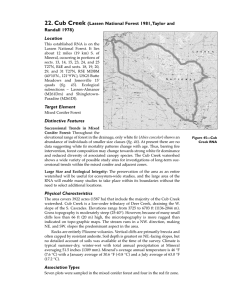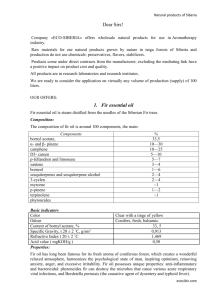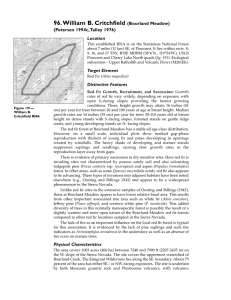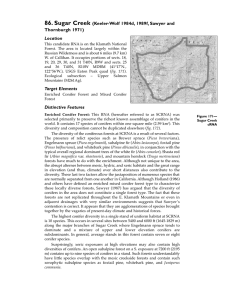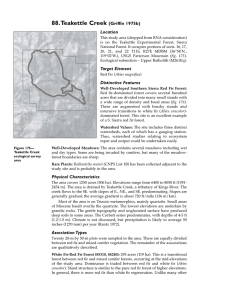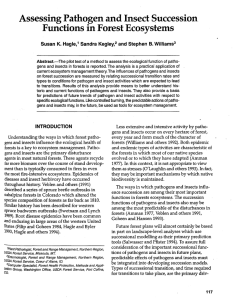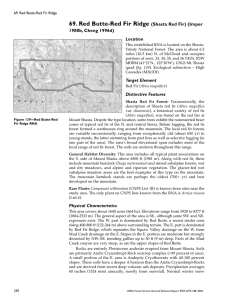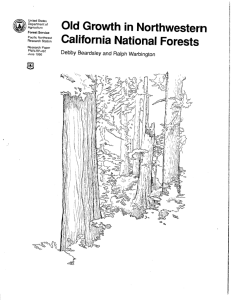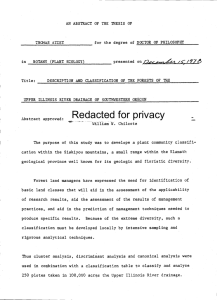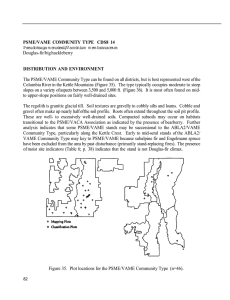85. Station Creek (Bald Mountain) (Taylor and Randall 1977a, Berg 1990) Location
advertisement
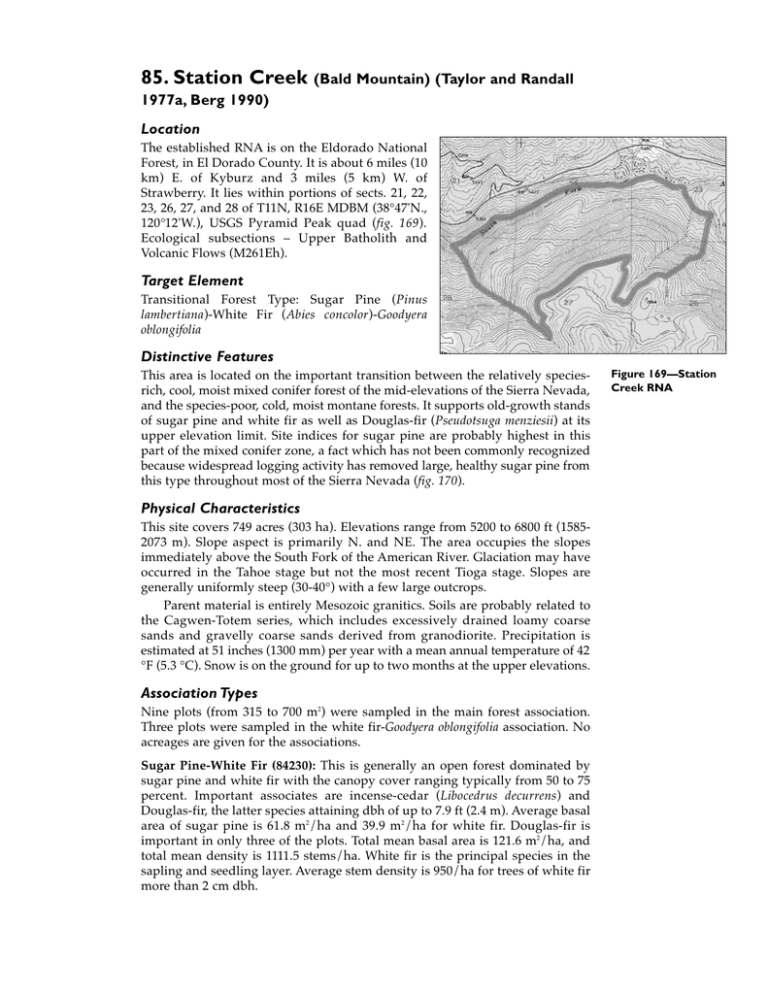
85. Station Creek (Bald Mountain) (Taylor and Randall 1977a, Berg 1990) Location The established RNA is on the Eldorado National Forest, in El Dorado County. It is about 6 miles (10 km) E. of Kyburz and 3 miles (5 km) W. of Strawberry. It lies within portions of sects. 21, 22, 23, 26, 27, and 28 of T11N, R16E MDBM (38°47'N., 120°12'W.), USGS Pyramid Peak quad (fig. 169). Ecological subsections – Upper Batholith and Volcanic Flows (M261Eh). Target Element Transitional Forest Type: Sugar Pine (Pinus lambertiana)-White Fir (Abies concolor)-Goodyera oblongifolia Distinctive Features This area is located on the important transition between the relatively speciesrich, cool, moist mixed conifer forest of the mid-elevations of the Sierra Nevada, and the species-poor, cold, moist montane forests. It supports old-growth stands of sugar pine and white fir as well as Douglas-fir (Pseudotsuga menziesii) at its upper elevation limit. Site indices for sugar pine are probably highest in this part of the mixed conifer zone, a fact which has not been commonly recognized because widespread logging activity has removed large, healthy sugar pine from this type throughout most of the Sierra Nevada (fig. 170). Physical Characteristics This site covers 749 acres (303 ha). Elevations range from 5200 to 6800 ft (15852073 m). Slope aspect is primarily N. and NE. The area occupies the slopes immediately above the South Fork of the American River. Glaciation may have occurred in the Tahoe stage but not the most recent Tioga stage. Slopes are generally uniformly steep (30-40°) with a few large outcrops. Parent material is entirely Mesozoic granitics. Soils are probably related to the Cagwen-Totem series, which includes excessively drained loamy coarse sands and gravelly coarse sands derived from granodiorite. Precipitation is estimated at 51 inches (1300 mm) per year with a mean annual temperature of 42 °F (5.3 °C). Snow is on the ground for up to two months at the upper elevations. Association Types Nine plots (from 315 to 700 m2) were sampled in the main forest association. Three plots were sampled in the white fir-Goodyera oblongifolia association. No acreages are given for the associations. Sugar Pine-White Fir (84230): This is generally an open forest dominated by sugar pine and white fir with the canopy cover ranging typically from 50 to 75 percent. Important associates are incense-cedar (Libocedrus decurrens) and Douglas-fir, the latter species attaining dbh of up to 7.9 ft (2.4 m). Average basal area of sugar pine is 61.8 m2/ha and 39.9 m2/ha for white fir. Douglas-fir is important in only three of the plots. Total mean basal area is 121.6 m2/ha, and total mean density is 1111.5 stems/ha. White fir is the principal species in the sapling and seedling layer. Average stem density is 950/ha for trees of white fir more than 2 cm dbh. Figure 169—Station Creek RNA Chrysolepis sempervirens is a constant understory shrub. A total of 25 understory species are recorded on the sample plots, and they include Symphoricarpos acutus, Pyrola picta, Smilacina racemosa ssp. amplexicaulis, Hieracium albiflorum, Pedicularis semibarbata, Apocynum pumilum, Galium bolanderi, Carex rossii, C. multicaulis, Adenocaulon bicolor, Pteridium aquilinum var. pubescens, and Chrysopsis breweri. White Fir-Goodyera oblongifolia (84240): This association forms a matrix with the previous association and predominates where snow cover is deeper (higher elevations or more directly N.-facing exposure) than the previous type. There is a dense and closed canopy of A. concolor with only occasional larger individuals of sugar pine (although seedlings are more common). Sampling indicates a mean tree density of 1018 stems/ha and mean basal area cover of 97.4 m2/ha. White fir comprises 95 percent of the total cover and 94 percent of the total number of stems. The understory is very sparse (<5 percent cover). Corallorhiza maculata and Pleuricospora fimbriolata are locally restricted to this type. Other herbs and shrubs in this type include Salix scouleriana, Rubus parviflorus, Galium triflorum, Chrysopsis breweri, and Arceuthobium campylopodum. Hydric Associations (45400, 63500): Although not specifically treated in the survey, a number of species in the plant list are hydrophilic and suggest that seep and montane riparian situations exist in the area. In the RNA establishment record, all 749 acres (303 ha) are gouped into one vegetation type: Sierran Mixed Conifer Forest (84230). Plant Diversity One hundred eleven species are listed. Conflicting impacts The N. boundary of the area is formed by the South Fork of the American River. Summer homes and campsites adjacent to Highway 50 border the river along the boundary of the study area. Thus, the area is accessible to a potentially large number of people. However, no negative impacts are discussed. Recent observation following the survey shows the sugar pines to be infected with white pine blister rust. Figure 170—Station Creek, steep slope with multi-aged forest dominated by sugar pine and white fir in Station Creek RNA. (L. Johnson 1975)
